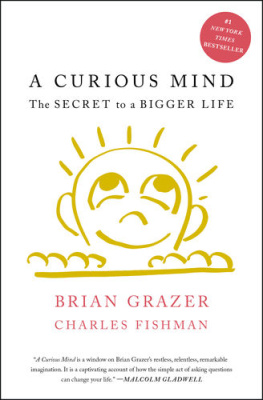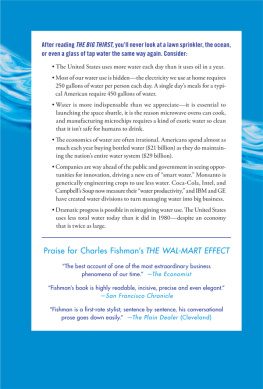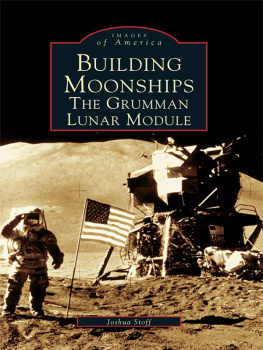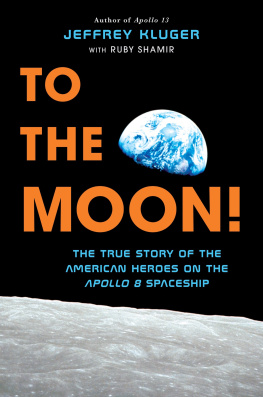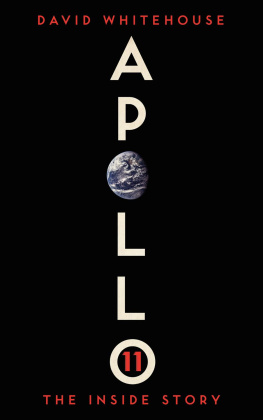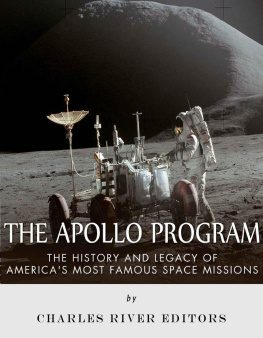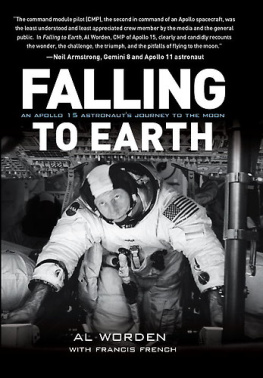ALSO BY CHARLES FISHMAN
The Big Thirst
The Wal-Mart Effect

Simon & Schuster
1230 Avenue of the Americas
New York, NY 10020
www.SimonandSchuster.com
Copyright 2019 by Charles Fishman
All rights reserved, including the right to reproduce this book or portions thereof in any form whatsoever. For information, address Simon & Schuster Subsidiary Rights Department, 1230 Avenue of the Americas, New York, NY 10020.
First Simon & Schuster hardcover edition June 2019
SIMON & SCHUSTER and colophon are registered trademarks of Simon & Schuster, Inc.
For information about special discounts for bulk purchases, please contact Simon & Schuster Special Sales at 1-866-506-1949 or business@simonandschuster.com.
The Simon & Schuster Speakers Bureau can bring authors to your live event. For more information or to book an event, contact the Simon & Schuster Speakers Bureau at 1-866-248-3049 or visit our website at www.simonspeakers.com.
Interior design by Lewelin Polanco
Jacket design by Richard Ljoenes
Jacket photograph of Apollo 11 From Wikipedia, Public Domain; Moon Image
From Nasa/Goddard Space Flight Center Scientific Visualization Studio
Library of Congress Cataloging-in-Publication Data is available.
ISBN 978-1-5011-0629-3
ISBN 978-1-5011-0631-6 (ebook)
PHOTO CREDITS
Insert One : NASA, John Hancock/Apollo Lunar Surface Journal
Insert Two : NASA
TO NICOLAS
Who always reaches for the Moon, and whose footprints are on these pages, and on my heart
PREFACE
The Mystery of Moondust
Boy this thing sure flies nice.
Pete Conrad, Apollo 12 commander
at the controls of lunar module Intrepid, preparing to fly to a pinpoint landing on the Moon
T he Moon has a smell.
It has no air, but it has a smell.
Each pair of Apollo astronauts to land on the Moon tramped lots of Moondust back into the lunar moduleit was deep gray, fine-grained and extremely clingyand when they unsnapped their helmets, they immediately noticed the smell.
We were aware of a new scent in the air of the cabin, said Neil Armstrong, the first man to set foot on the Moon, that clearly came from all the lunar material that had accumulated on and in our clothes. To Armstrong, it was the scent of wet ashes. To his Apollo 11 crewmate Buzz Aldrin, it was the smell in the air after a firecracker has gone off.
All the astronauts who walked on the Moon noticed it, and many of them commented on it to Mission Control. Harrison Schmitt, the geologist who flew on Apollo 17, the last lunar landing, said after his second Moon walk, Smells like someones been firing a carbine in here. Almost unaccountably, no one had warned lunar module pilot Jim Irwin about the dust. When he took off his helmet inside the cramped lunar module cabin, he said, Theres a funny smell in here. His Apollo 15 crewmate
Moondust was a mystery that the National Aeronautics and Space Administration had, in fact, thought about. Cornell University astrophysicist Thomas Gold warned NASA that the dust had been isolated from oxygen for so long that it might well be highly chemically reactive. If too much dust was carried inside the lunar modules cabin, the moment the astronauts repressurized it with air and the dust came into contact with oxygen, it might start burning, or even cause an explosion. (Gold, who correctly predicted early on that the Moons surface would be covered with powdery dust, also had warned NASA that the dust might be so deep that the lunar module and the astronauts themselves could sink irretrievably into it.)
Among the thousands of things they were keeping in mind while flying to the Moon, Armstrong and Aldrin had been briefed about the very small possibility that the lunar dust could ignite. It was, said Aldrin, the worry of a few. A late-July fireworks display on the Moon was not something advisable.
Armstrong and Aldrin did their own test. They took a small sample of lunar dirt that Armstrong had scooped into a lunar sample bag and put in a pocket of his spacesuit right as he stepped onto the Moona contingency sample in case, for some reason, the astronauts had to leave suddenly without collecting rocks. Back inside the lunar module the astronauts opened the bag and spread the lunar soil out on top of the ascent engine. As they repressurized the cabin, they watched to see if the dirt started to smolder. If it did, wed stop pressurization, open the hatch and toss it out, explained Aldrin. But nothing happened.
The Moondust turned out to be so clingy and so irritating that on the one night that Armstrong and Aldrin spent in the lunar module on the surface of the Moon, they slept in their helmets and gloves, in part to avoid breathing the dust floating around inside the cabin.
NASA had anticipated the dust, and the danger. The smell was a surprise.
By the time the Moon rocks and dust got back to Eartha total of 842 pounds from six lunar landingsthe smell was gone. Scientists think the rocks and dirt were chemically reactive, as Gold theorized, but that the air and moisture the rocks were exposed to in their sample boxes on the way to Earth pacified them, releasing whatever smell there was to be released.
Scientists who have studied the rocks and dirt and handled them and sniffed them say they have no odor at all. And no one has quite figured out what caused it, or why it was so like spent gunpowder, which is chemically nothing like Moon rock. Very distinctive smell, said Apollo 12 commander Pete Conrad. Ill never forget. And Ive never smelled it again since then.
In 1999, as the century was ending, the Pulitzer Prizewinning historian Arthur Schlesinger Jr. was among a group asked what the most significant human achievement of the 20th century was. In ranking the events, Schlesinger said, I put DNA and penicillin and the computer and the microchip in the first 10 because theyve transformed civilization. But in 500 years, if the United States of America still exists, most of its history will have faded to invisibility. Pearl Harbor will be as remote as the War of the Roses, said Schlesinger. The one thing for which this century will be remembered 500 years from now was: This was the century when we began the exploration of space. He picked the first Moon landing, Apollo 11, as the most significant event of the 20th century.
The leap from one small planet to its even smaller nearby Moon may well look modest when space travel has transformed the solar systema trip no more ambitious than the way we think of a flight from Dallas to New York City today. But it is hard to argue with Schlesingers larger observation: in the chronicle of humanity, the first missions by people from Earth through space to another planetary body are unlikely ever to be lost to history, to memory, or to storytelling.
The leap to the Moon in the 1960s was an astonishing accomplishment. But why? What made it astonishing? Weve lost track not just of the details; weve lost track of the plot itself. What exactly was the hard part?
The answer is simple: when President John Kennedy declared in 1961 that the United States would go to the Moon, he was committing the nation to do something we couldnt do. We didnt have the tools, the equipmentwe didnt have the rockets or the launchpads, the spacesuits or the computers or the zero-gravity foodto go to the Moon. And it isnt just that we didnt have what we would need; we didnt even know what we would need. We didnt have a list; no one in the world had a list. Indeed, our unpreparedness for the task goes a level deeper: we didnt even know how to fly to the Moon. We didnt know what course to fly to get there from here. And, as the small example of lunar dirt shows, we didnt know what we would find when we got there. Physicians worried that people wouldnt be able to think in zero gravity. Mathematicians worried that we wouldnt be able to work out the math to rendezvous two spacecraft in orbitto bring them together in space, docking them in flight both perfectly and safely. And that serious planetary scientist from Cornell worried that the lunar module would land on the Moon and sink up to its landing struts in powdery lunar dirt, trapping the space travelers.
Next page
